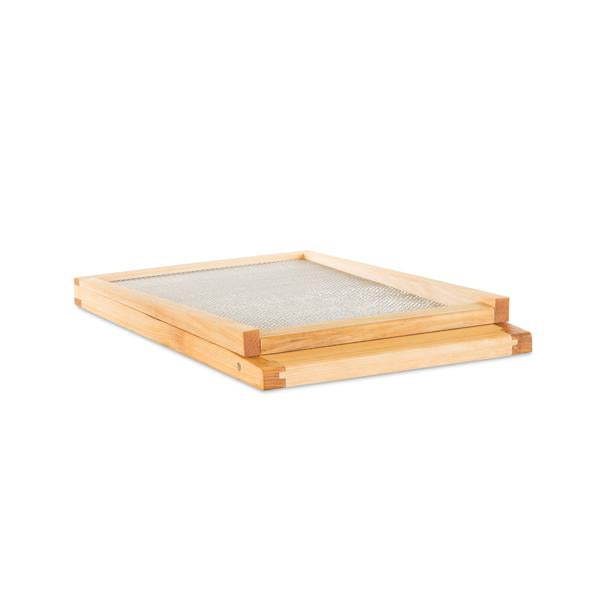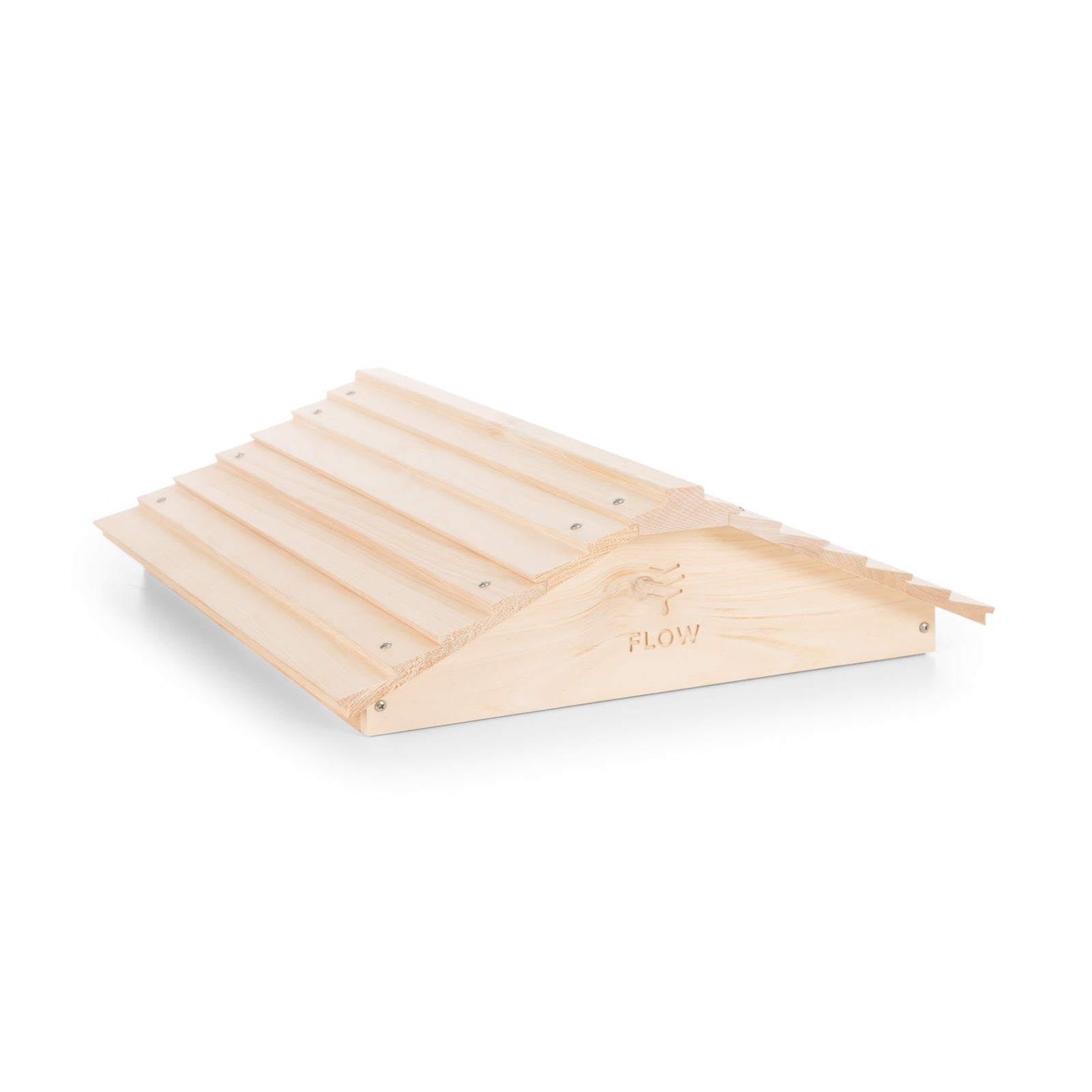Your Cart is Empty
How to Catch a Swarm
by Hilary Kearney 7 min read
Catching a swarm of bees is one of the most joyous parts of beekeeping and it is an easy and free way to bolster your apiary! Read on to find out how you can catch a swarm.
- About swarms
- Timing
- Temperament
- What you'll need
- How to get the bees into the Flow Hive
- Did you get the queen?
- Give them time
- Do not disturb

About swarms
Honey bees swarm in spring when their colony grows large and overcrowded with bees. It is their way of relieving congestion of the colony and it is also how their species creates new bee colonies. When it is time to swarm, the queen and roughly half the bees leave the colony in search of a new place to live. Swarms often take breaks on their journey to their new home and may be found resting in a tree or bush.
Swarms are easy for beekeepers to catch and relocate because, at this stage, they seldom have comb. A true swarm has not settled in its new home and so they will not have started to build. They are just a cluster of bees. Without the complication of comb, a beekeeper can easily scoop, shake or lower the swarm into their equipment and bring them back to their apiary.
See our swarm prevention tips to help manage swarming in your colonies.
Timing
The best time to catch a swarm is as soon as you find out about them. A swarm of bees is, by definition, unsettled and will not stay put for long. A swarm may rest in one location for only an hour or they may stay for several days, but the beekeeper has no way of knowing which it will be.
I’ve often rushed out to capture a swarm only to have it leave in the short window of time it took me to get there. During the swarm season, I like to keep everything I need to catch a swarm in my car. That way I can get to them more quickly.
Temperament
Capturing a swarm of bees is magical. No matter how many I catch, I am still filled with childlike glee when they start to swirl around me. One of the things that make the process so enjoyable is that swarms are almost always docile.
Established colonies tend to be defensive. They may sting to protect their home, their brood, and their honey, but a swarm of bees has no home, brood or honey stores. Therefore, they have no reason to sting. It is also said that swarms are less likely to sting because they are full of honey. Each worker carries a small amount of honey inside her honey gut. This honey will help to fuel the work of building a new hive.
It should be noted that on occasion, a swarm will be defensive. Many beekeepers catch swarms without wearing bee suits, but new beekeepers especially should beware of this possibility.
It should also be noted that while most swarms will start out sweet, they will almost certainly become more defensive once they become established. If you are in an Africanized area, this change can be dramatic. Initially, there is no way to tell if you are catching an Africanized swarm or not. It can take several weeks before the bees reveal their true nature.
What you’ll need
The main thing you need for catching a swarm is something to put them in. When selecting a container, make sure you have something big enough to accommodate the size of the swarm you are catching. The size of each swarm can vary from something as small as a baseball to something as big as a couple of basketballs. I find most swarms are about the size of a football. Your container can be anything: a cardboard box, a bucket, a plastic container, a nuc box or you can put them directly into your Flow Hive.
If you do decide to transfer them directly into your Flow Hive, you need only bring the brood box with you. There is no need to bring the Flow super, you can add it later once your swarm has started to build comb and fill the first box. I also like to leave the Flow Hive peaked roof at home when catching a swarm. The hive is easier to manage during transport with just the inner cover. I tape a piece of screen or paper over the hole. If you do use a bucket or cardboard box, just know you will need to transfer the bees a second time into your Flow Hive once you get home. If you can put them directly into their permanent home during the catching process, this will save you and the bees some time and effort!
You’ll need a new home for the bees - this can be a brood box or a smaller nuc box to let them get established. We’ve put together a swarm kit so you can be prepared.
Depending on where the swarm has landed you may need a few other things for catching them. If they are up high, you may need a ladder, or to use a long pole. If they are deep in a shrub, you may need some plant clippers. If you haven’t seen the swarm in person, make sure you ask about the position of the swarm so you can arrive prepared.
Check out our blog with great videos on How to catch a swarm high in a tree.
How to get the bees into the Flow Hive
So, how do you actually get the bees into your container or Flow Hive? There are three simple methods, but the best option can vary depending on the specific situation.
Clip and lower
Generally, the best way to get a swarm in your box is to lower them in. This scenario is usually possible when the bees are hanging from a small branch. You simply clip (cut) the branch and lower it into your brood box. Make sure to leave the frames in and place the swarm on top of them. They will run down and hang from the tops of the frames. If you put the bees in first and then try to put the frames in afterwards, you will have trouble doing it without squishing bees!
Lowering the bees into the box means virtually none of the bees will be separated from the swarm. A few will fly, but most will stay in formation and then regroup in your box. Some believe this method also makes the bees feel like they have chosen to move, which increases the likelihood that they will stay in your Flow Hive.
Shake
If the bees are on a branch that is out of reach or too thick to cut, you can shake them. This method is quick and if your aim is good, it is effective. Just give the branch a single, strong shake and the cluster will fall in a big clump into your box. The downside of this method is that many of the bees will fly and become confused. Some will return to the branch you shook them from, others will land nearby. Basically, bees will go everywhere and it will take more time for them to regroup in your box. However, the majority of them – and probably the queen – will end up in your box.
Scoop
When the bees are on something that prevents them from being lowered or shaken, they can usually be scooped by hand. Some even prefer this over shaking because it’s easier to keep the bees from flying. Once you scoop several handfuls, the bees will start to move of their own accord into the box. If they don’t, just keep scooping.
Did you get the queen?
When the bees start excitedly streaming into the box and fanning at the entrance there’s a good chance that you got the queen or that they have decided to move into the box and the queen will follow. If the bees exhibit this behavior in a location that is not your box, do some investigating because you might find the queen there!
Give them time…
Once you’ve got most of the bees into your box, you’ll need to position it in a way that makes it accessible to the remaining bees. The flying bees will return to the original location of the swarm so you will want to place your box as close to the original location as possible. Then you wait. If possible, wait until dusk to close the box and move the bees away. This will ensure that all of the foragers are back and no bee is left behind. If you must take it in the middle of the day, many bees will be left behind.

Do not disturb
After catching your new swarm, it is important not to disturb them for one week. This is the amount of time it will take them to build comb and start raising brood. If you bother them before that point, they may become annoyed and decide to abscond. Remember, they have nothing invested in your hive at this point. No comb, honey or brood!
In fact, swarms often abscond even when they haven’t been disturbed! Some tricks for getting them to stay include: using a hive that bees have lived in before, tacking a queen excluder over the entrance, giving the bees some empty comb, or best of all giving the bees some open brood comb from another hive.
You may also want to check out our other great video on How to catch a swarm of bees.
If you want to be prepared for swarming season with extra brood boxes, accessories, or a full hive setup, then Flow Hive has you covered. Our revolutionary harvesting system allows you to collect honey from the hive without disturbing the bees.
And if you’re new to beekeeping, check out our starter beehive kit for a special offer that includes everything you need to get up and running. We also offer lots of support and helpful resources for beginner beekeepers.
SHOP NOW
Hilary Kearney is a full-time beekeeper in her hometown of San Diego, California. Her business Girl Next Door Honey educates hundreds of new beekeepers each year. She is the author of the Beekeeping Like A Girl blog and maintains popular Instagram, Facebook and Twitter accounts. When she’s not rescuing bees, teaching about bees, photographing bees or managing one of her 60 colonies, she’s sleeping and dreaming of bees.






